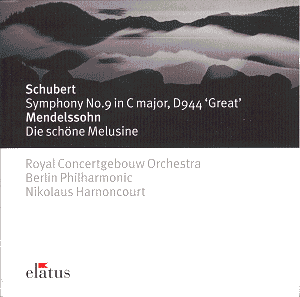This work of Schubert is astonishing, overwhelming,
no matter how many times you’ve heard it. Built out of ordinary classical
period bricks and mortar, in uninspired hands it can be an excruciating
60 minutes of hum-de-dum (e.g., the Los Angeles Philharmonic Orchestra
in 1956). But played by motivated musicians it arouses an all but erotic
sense of lightness in the belly, a breathlessness, light-headedness.
(track 1) It is like the morning sun slowly rising through the mist
after a heavy snow. It is a flamenco festival of frenzied stamping rhythms
and hats thrown high in the air. (track 4) There is about it a Tristan-like
sense of ever rising modulation, of ever brightening luminosity. The
quotation in the last movement from Beethoven’s Ninth Symphony
is really a joke, because after this work not only Götterdämmerung
but even Le Sacre were inevitable. Tovey suggested that if Schubert
had lived his full life he would have rendered all of Brahms superfluous.
Is it really so surprising then that at the rehearsals for the first
performance at the Gewandhaus this most solemnly professional orchestra
then in the world just started laughing and couldn’t stop?
The all time great recording of the work is by George
Szell and the Cleveland Orchestra from 1957 on Sony, dated sound and
all. The ecstatic poetic images of my previous paragraph are fully manifested.
The tempo is brisk and actually rock steady, but there is the sense
of rapid acceleration throughout. The music lifts into the air and does
not touch ground again until the final cadential chord. There should
be a label on the box warning persons tending to high blood pressure
not to listen. Harnoncourt is every bit as good, but different here
and there, and has the edge of exquisitely full, rich, transparent sound.
Another exceptional recent recording, Claudio Abbado and the Berlin
Philharmonic Orchestra, is a very honourable third choice. The voltage
is a little lower. The sound is well balanced with excellent depth.
The colors are brighter with the shadows a little more crimson. The
coupling is a superb Rosamunde/Zauberharfe Overture. It is for those
who, like Ulysses, prefer to listen to the siren song securely chained
to the masthead. One of these three, all of them if you can, must be
in every collection.
The djin in this work apparently does not restrict
itself the music which has ever been the victim of shifting appellation.
Produced in utterly unannotated form by the composer, it was called
the "Great C Major" (to distinguish it from Schubert’s Symphony
#6, called by the same people the "Little C Major") and this
is now sometimes shortened to just "The Great." Originally
numbered 7, then 9, most scholars have now re-fastened it securely in
place as #7, yet on the original issue of this recording it was billed
for the first time as "#8," while on the label for this reissue
of the same recording it is announced as "#9." Stay tuned!
Mendelssohn (Who conducted that premier performance
of the Schubert in Leipzig) was inspired to write his concert overture
Fair Melusina (track 5) upon hearing Conrad Kreutzer’s opera
Melusine in 1833, sort of to show how it ought to have been done.
Here she gives us all she’s got to give in these sympathetic hands.
She’s a sort of replay of "Fingal’s Cave" with a little more
grace and a lot less drama. After the multi-course haute-cuisine
of the Schubert, this is a welcome after dinner mint.
Paul Shoemaker
